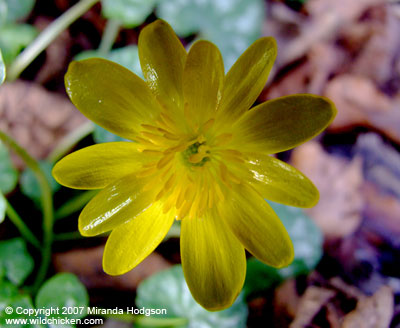


Ranunculus ficaria (also called lesser celandine and pilewort)
Ranunculus
ficaria
Deciduous perennial seen in woodland, hedgerows and sometimes gardens. Celandine flowers early, in late winter, and whilst the flowers bring welcome colour to us, and food for insects, it can quickly become an invasive weed, especially if it gets into a lawn.
I would hesitate to call celandine a 'garden plant' but it does end up in some gardens. Saying that, if you have a large area that needs brightening up in early spring, such as an area of woodland, the banks of a stream or lake, it can be useful. When I say 'large', think of the huge swathes of celandine you see in woodland and that will give you an idea of its ability to spread.
The plant grows from root-tubers which break apart easily when the plant is dug up. Each piece of tuber will become a new plant and, because they are quite small, it is difficult to remove them from the soil.
Flowers and foliage in late winter and early spring.
Habit - spreading. H: up to 20cm. Spread: indefinite.
Leaves - rounded heart shape, glossy, dark green with silvery splotches.
Flowers - open and simple, with 8-12 petals and yellow stamens. The petals are bright yellow above, and tinged with olive green beneath.
Full sun to dappled shade.
Any reasonably fertile, moisture retentive soil.
Fully hardy.
None.
Needs no help from us and spreads mainly by tubercles (bulbils) that form in the leaf axils. The plants also sometimes produce viable seed.
Garden Plant Information list of plant care info by botanical name